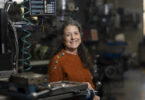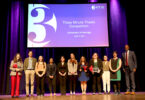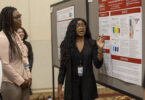In 2015, the university had 6,974 students seeking master’s and doctoral degrees, and it is looking to increase those numbers in a strategic manner, said David C. Lee, vice president for research.
“We don’t want to just increase the number of graduate students,” he said. “We also want to improve the quality of our graduate programs and the experience graduate students have at UGA.”
In order to do this, the university is looking to expand and improve its interdisciplinary research activities, since this is essential to solving the world’s most pressing issues.
“We can no longer afford to work as individual researchers or even individual laboratories,” Lee said. “The problems that we’re being expected to find solutions to are on a grand scale. Universities are increasingly expected to be a part of the solution to the very significant problems that we face as a global society.”
The university wants to be smart about how it spends inevitably limited resources to grow its programs, he said, noting that one of UGA’s priorities is to make good investments in infrastructure.
“It takes quality space to do research in – appropriately designed, safe and functional space,” Lee said. “It also has to be attractive space to attract high-quality researchers. And we have to be able to provide our researchers, particularly our scientists and engineers, with access to often costly, high-end instrumentation that is located in core facilities.”
An example of these core facilities is the BioImaging Research Center, which contains a suite of instrumentation for collecting images of tissues in the body. While the average faculty member or individual program can’t afford such state-of-the-art equipment on their own, they can sign up to use the BIRC and use grant-designated funds to cover the costs.
Another example of being smart with investments is focused on growing infectious disease research, particularly from a “One Health” perspective. One Health is a concept that recognizes the important interplay between human, animal and environmental health, Lee said.
“So why is that a good sweet spot for UGA? Well, we’ve been known for decades as a school that has strong environmental sciences and ecology,” Lee explained. “It’s the university where Eugene Odum, who many recognize as the pioneer of ecology, did a lot of his groundbreaking work. We have a college of veterinary medicine here that’s actually located on campus, so we have a lot of experience and capabilities in aspects of animal health. And they have a very strong focus on infectious diseases. Add to these elements, our growing strength in human health and you can see why we’ve encouraged this as one of our smart, strategic growth areas.”
 Suzanne Barbour, dean of the Graduate School: “If you’re going to be successful in research, then you have to have well-trained, ambitious, talented graduate students.”
Suzanne Barbour, dean of the Graduate School: “If you’re going to be successful in research, then you have to have well-trained, ambitious, talented graduate students.”
But growing the research enterprise requires growing the graduate student population.
“In order to do research, you have to have a workforce. That workforce is largely graduate students,” said Suzanne Barbour, dean of the UGA Graduate School. “If you’re going to be successful in research, then you have to have well-trained, ambitious, talented graduate students, otherwise, your research engine just falls apart.”
The Graduate School is also focusing on increasing the number of students from minority and other underrepresented groups.
“The fact is we’re still not training enough students from underrepresented groups,” Barbour said. “We’re still not training enough students who come from first-generation families, who are the first in their family to go to college, to go to graduate school, students who are of ethnic and racial minority. If we’re to continue to be a global leader in research and scholarship, it’s essential that we train more students who look like the demographics of our country.”
“It’s often graduate students, combined with undergraduates, technical staff and sometimes post-doctoral research associates, who actually do the research. They’re doing something important, and they’re getting a great education in return.”
 David Lee, vice president for research: “For many of our research laboratories, graduate students are really the foot soldiers in a sense. They make the research happen.”
David Lee, vice president for research: “For many of our research laboratories, graduate students are really the foot soldiers in a sense. They make the research happen.”
— David Lee
Research opportunities are also integral in attracting these talented potential grad students, Barbour went on to add. “We are best positioned to train graduate students in areas where we have research strength. Conversely, outstanding graduate students contribute to our research strength.”
“For many of our research laboratories, graduate students are really the foot soldiers in a sense,” Lee explained. “They make the research happen. The faculty member gets the grant to do something interesting, something important, something that a funding agency has decided is worth funding, but faculty have lots of responsibilities including teaching, serving on committees, all sorts of things.
“It’s often graduate students, combined with undergraduates, technical staff and sometimes post-doctoral research associates, who actually do the research. They’re doing something important, and they’re getting a great education in return. It’s really an apprenticeship. And they don’t just do the work; graduate students often bring a creative spark as well.”
But grad students don’t just do research. They present their research and share their findings with the public, which is where conferences like the Interdisciplinary Research Conference, held by the Graduate Student Association in February, came into play.
“It was a nice venue for graduate students to feel like they actually have a platform on which to present what they are doing, to present it as their own work,” said June Brawner, director of the Interdisciplinary Research Conference and vice president of the Graduate Student Association. “I think there’s a lot of research, a lot of labor … that graduate students are doing, but we’re not always maybe on the publication or we’re not in the limelight. So this is just a really cool moment to think about what grad students are doing on campus and how we’re really helping the university run and operate the way that it’s supposed to.”
Gretchen Sneegas, a second-year doctoral student in geography, was one student who took advantage of that opportunity.
Sneegas conducted a two-part workshop on what the concept of interdisciplinary research means to people. The workshop started a project Sneegas hopes will eventually turn into a collaborative research project down the road.
Conferences like the Interdisciplinary Research Conference are important opportunities for graduate students because they build students’ communication skills on their topics of interest, Barbour said.
“They’re critical for students who want to teach, obviously, because they have to communicate their disciplines to students,” she said. “They’re also critical for people who want to get funding for their work because they to communicate their work to funding agencies.
“Students should have the skill sets necessary to communicate what they’re doing to the general public, whose taxpayer dollars pay, in part, for their work.”
Brawner, a third-year doctoral student in anthropology and a second-year master’s student in crop and soil sciences, said she hopes the administration takes note of the 250 people who registered for the conference and offers more opportunities like it.
“If I were considering going to a university and doing research and I looked at UGA and I saw things like this more often and even bigger and better, I think that that would be a real draw for me,” Brawner said.
— Leigh Beeson, Division of Marketing & Communications








